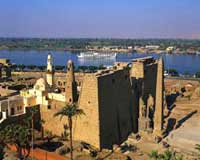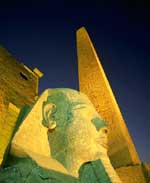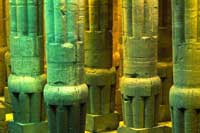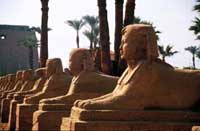|
The Temple of Luxor
 Many festivals were celebrated in Thebes. The Temple of Luxor
was the center of the most important one, the festival of Opet.
Built largely by Amenhotep III and Ramesses II, it appears that
the temple's purpose was for a suitable setting for the rituals
of the festival. Many festivals were celebrated in Thebes. The Temple of Luxor
was the center of the most important one, the festival of Opet.
Built largely by Amenhotep III and Ramesses II, it appears that
the temple's purpose was for a suitable setting for the rituals
of the festival.
The festival itself was to reconcile the human aspect of the
ruler with the divine office.
 During the 18th Dynasty the festival lasted eleven days, but had
grown to twenty-seven days by the reign of Ramesses III in the
20th Dynasty. The procession of images of the current royal
family began at Karnak and ended at the temple of Luxor. During the 18th Dynasty the festival lasted eleven days, but had
grown to twenty-seven days by the reign of Ramesses III in the
20th Dynasty. The procession of images of the current royal
family began at Karnak and ended at the temple of Luxor.
By
the late 18th Dynasty the journey was being made by barge, on
the Nile River. Each god or goddess was carried in a separate
barge that was towed by smaller boats.
 Once at the temple, the king and his priests entered the back
chambers. Once at the temple, the king and his priests entered the back
chambers.
There, the king and his ka (the divine essence of each king,
created at his birth) were merged, the king being transformed
into a divine being.
 The
temple of Luxor used to be connected to the Karnak Temple via a
long stone processional street called a dromos. The dromos was
built by Nectanebo I, and originally was lined on either side by
sphinxes. In front of the Luxor temple, the dromos is well
preserved, and on the way to the entrance one passes by a Roman
chapel of burnt brick dedicated to the god Serapis, which was
built during the rule of Hadrian. There is a path that leads to
the Nile side of the Temple where one enters the complex. The
temple of Luxor used to be connected to the Karnak Temple via a
long stone processional street called a dromos. The dromos was
built by Nectanebo I, and originally was lined on either side by
sphinxes. In front of the Luxor temple, the dromos is well
preserved, and on the way to the entrance one passes by a Roman
chapel of burnt brick dedicated to the god Serapis, which was
built during the rule of Hadrian. There is a path that leads to
the Nile side of the Temple where one enters the complex.
The
Temple of Luxor has a great pylon with carved episodes from the
Battle of Kadesh when Ramses defeated the Hittites. There is the
one red granite obelisk (a twin one is now at the Place de la
Concorde in Paris |